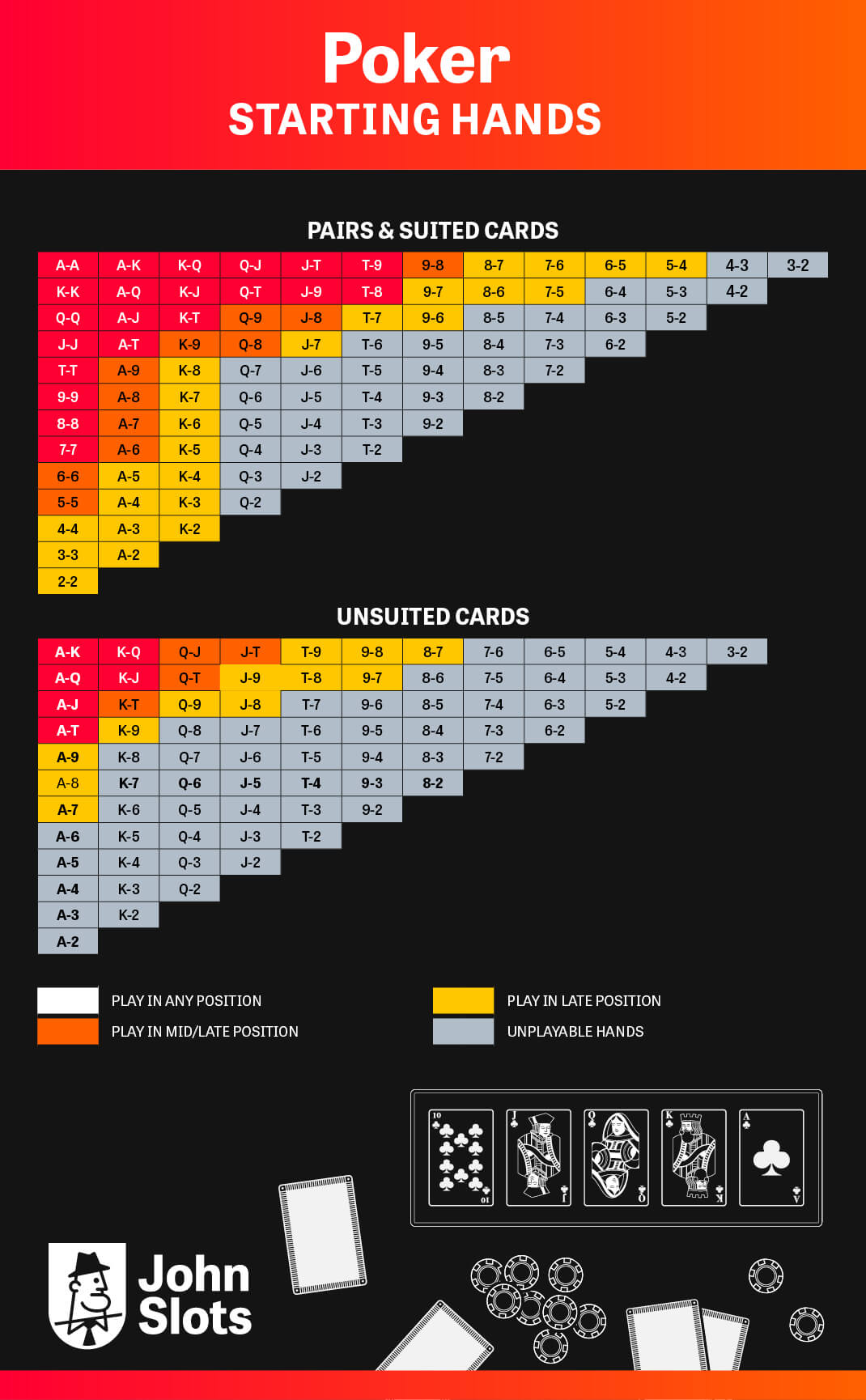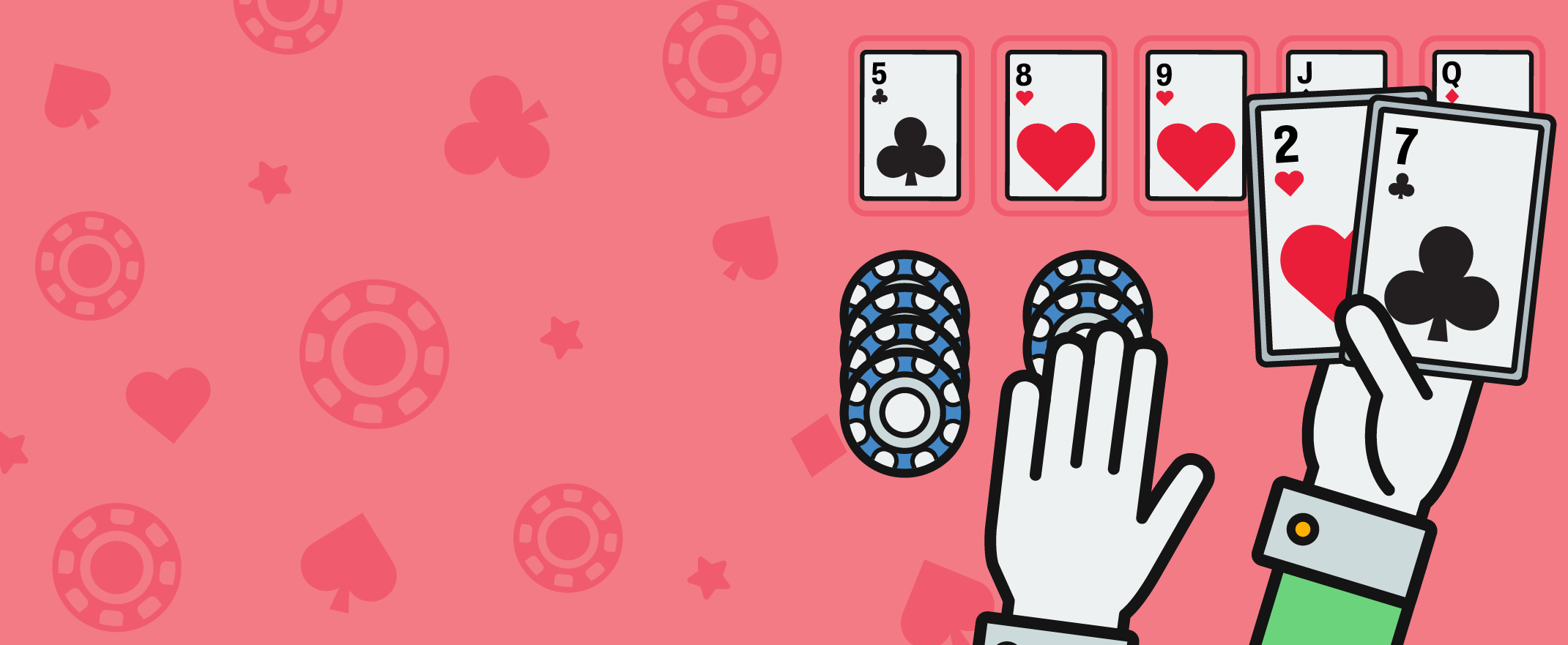This is where poker strategy comes in. There are multiple actions a player can take when it’s their turn to play and choosing the correct course of action requires critical thinking. This poker strategy guide is aimed at demystifying certain poker terms, common mistakes new players make and poker tips on how to make the right choices at the right time.
Reasons to raise
Raising the bet can be done for any number of reasons and is part of an aggressive style of play, which we will talk about a little later. Experienced players will raise to do one or more of the following:
- Thin the field: The fewer players competing for the pot, the fewer players you will need to beat in order to win. Raising thins out the field by discouraging players with less confidence in their hands to bow out
- Raise the value of your hand: If you have a strong hand, you will instinctively want to increase the pot size for a larger win.
- To take control: Raising pre-flop gives other players the impression that you have a strong hand, which will encourage them to check to you after the flop in order to see what you are going to do next. This gives you control of the hand.
- Project strength: This tacks on to the previous point. By projecting confidence, even if you are just bluffing, it can make other players decide their hand is not worth it and to fold. That said, for this to work, it needs to be a high, aggressive raise to avoid being called by a player who doesn’t believe you.
Reasons to call
It is often said that raising is aggressive while calling is the cautious choice. While raising can be used to intimidate other players, calling is useful in other ways and can be used strategically to the player’s advantage.
- Protecting yourself: Cautious play, particularly when in early positions, can reduce the risk of losing large amounts
- Gathering information: Sitting out while in an early position can buy enough time for the player to get a feel for how opponents are betting and thus make inferences on what they believe is the strength of their cards. Knowledge is power and that knowledge will certainly come in handy later on in the game when you can put further poker techniques into play
Starting hands (preflop)
The starting hand is the one dealt preflop i.e. the two hole cards every player is dealt face-down before any other cards are dealt. The preflop cards they are dealt with will help a player decide whether to fold or not – some hands are just not worth proceeding with.
Pairs of Aces, Queens and Kings represent a strong start as both cards fall at the higher value end of the deck. Ace-King suited (i.e. of the same suit) are the next most desirable pair.
In mid-range value, where the chances of winning start to diminish slowly, we find a pair of tens, the Ace-Queen suited combination and the Ace-King off-suit. Of lower value still is the suited Ace-Jack combination and the King-Queen suited pair.
As you can see, high-value cards make for a better hand, with better potential. The flipside of that is the low-value cards. Pairs of low-value cards, suited or unsuited, are generally a poor bet and a good reason to fold. Even if the Ace is present, when paired with an unsuited low card there is little chance to win with this hand.

Hands to raise with
As mentioned earlier, the player’s position has a big impact on how they should proceed with betting. Those in later positions have the advantage over those who are in earlier positions as they have more information on their opponents to go on.
Late position players can choose to raise with more hands than earlier opponents. For instance, a player in the first position would only raise with very strong hands: pairs of Aces, Kings, jacks or Queens, Ace-King (un/suited), Ace-Queen (un/suited) or Ace-Jack unsuited.
A player in a later position can raise with those hands plus multiple combinations of face cards and even pairs of high number cards.
Hands to call with
Much like raising, deciding which hand to call on depends heavily on position. The player in the first position is very unlikely to call because they have zero information on their opponents if they do.
Players in late positions can choose to call on pairs of fives, sixes or sevens, suited or unsuited 10-Queen or 10-Jack combinations, 10-King unsuited or 9-Jack suited pairs.
Pot odds in flop
The pot odds are a ratio that represents the size of the pot in its entirety and the size of the current bet as a proportion of it.
Let’s use an example. The pot is currently at £2. An opponent has just bet £1. The pot odds, in this case, are 3:1, which tells the player that they have to pay a third of the pot to have a chance of winning the whole thing.
This bit of quick maths is the foundation for calling in poker, allowing the player to work out whether a call is profitable or not.
When it’s time to fold
The most common reason players fold during the flop is that they have taken one look at their hole cards and realised that they have an unwinnable hand. This could be an unsuited pair of low numbers, for example, that could beat very few or no other hands at all. It’s a disappointment but the great thing about poker is that the next round is never far away.
Another good reason to fold at this stage is that the pot odds are encouraging a call but you are not the last player closing the action, which means that someone playing behind you can make it too expensive to continue by raising.
Folding is one of those things that new players often get wrong, folding too often or too rarely, particularly early on in their poker experience. The key is to reach a balanced middle ground.
When you have a strong hand
When you have been dealt a hand you are fairly confident in, it can be the perfect opportunity to show some aggressive betting.
This can encourage weaker or less confident players to fold, thus thinning out the field of opponents, but be warned – unless you have the very highest value hand possible (i.e. a Royal Flush) there are hands that can beat yours and a player with an equally strong hand can easily up the ante at this point.
When you have a drawing hand
A drawing hand is one that is not yet complete, which means the player is relying on further community cards being dealt in order to hopefully create a valuable combination. Think of it as being one or more cards away from a combination such as a flush or a straight.
Odds are important in this situation. Let’s say the player has two diamonds on their hole cards, and two diamonds are set on the flop. We know there are a total of 13 diamond cards in a deck, which means that there 9 undealt diamonds in the deck at present. These are called outs.
The ratio between all the cards left in the deck (52 minus the already-dealt cards) and the cards we want to land (those 9 diamonds), gives us 38:9, or a more manageable 4:1. There is a 4 to 1 chance of landing a diamond flush in this case.
If the pot odds are better than the odds of landing the desired cards, the more profitable long-term choice is to call.
The importance of a poker face
Poker is as much about players as it is about cards. Players’ behaviour is a very useful indicator of how they feel about the strength of their hands and can be used, to some extent, to predict what they will do next.
The term ‘poker face’ is accurate for a very good reason – giving your opponents less to work with will be advantageous to you later.

Bluffing
Bluffing is manipulating what other players think about the hand you are currently playing. This can be done through betting. Aggressive betting gives the impression that a player’s hand is strong, which may or may not be the case. The objective of this is to induce one or more opponents to fold, thus reducing the number of players competing for the pot.
Late position players are in the best spot to use these poker tactics because they can put pressure on other players, who will have bet beforehand and will thus give clues as to what value their cards might have and how aggressive their betting will be going forward.
Semi-bluffing
The semi-bluff is a technique used to buy a player some time until the next card is drawn. The player will bluff on one round with a drawing or weak hand, which puts pressure on opponents while allowing the next card to be drawn and possibly completing the player’s hand advantageously.
Semi-bluffing can also induce other players to fold immediately, thus giving the player a better chance to win overall.
Slowplaying
This is the opposite of the bluff. Whereas a bluffing player bets high when their cards are not great, a slow play is a low bet that gives the impression of weak cards when in fact they are quite strong.
The objective here is to encourage opponents to raise when they might otherwise have folded because they assume the player has a weak hand.
Slow playing does have risks though. It does not protect against players whose hands might improve and there’s also the chance of reducing how much a pot is built if an opponent checks.
What is a tilt and how to avoid it?
This term comes from the world of pinball, where a player might tilt the machine in frustration. Tilt refers to the player’s emotional state as a result of bad luck or frustration. After a poor performance, the player might experience emotional upset that further hinders their ability to think clearly about how they are playing.
Poker can have high stakes, not just in terms of chips and bets but also in the player’s mental state. Repeated losses can take their toll, further impairing the player and leading to more losses.
The easiest way to avoid tilt is to stop playing. As soon as you feel like your emotional state is getting the better of you, the best thing to do is to stop and walk away for a while. Take a break and do something else. Do not get into discussions or arguments about your performance – simply stop doing anything poker-related for a spell to clear your head.
Preventing tilt takes a little more effort. Identify your own triggers – those events that will have you throwing all your knowledge out the window and taking impulsive or inappropriate actions. With this understanding, you are better prepared to deal with these events when they crop up.
Knowing the rules of the game and the probability associated with it can also help prevent tilting. A player who is familiar with these elements is less likely to feel out of their depth and make mistakes because of panic.
Different styles of play
Players can be categorised by the type and frequency of their bets.
Aggressive players bet or raise frequently, about twice as often as they call. Passive players bet or raise less often than they call.
Tight and loose refer to a player’s behaviour pre-flop. A tight player has very strict requirements when it comes to their starting hand and will fold frequently as a result. Loose players are happy to play the top 40% of starting hands, in contrast to the top 15% the tight player is willing to play.
These terms can be combined so a player can be described as tight-aggressive or loose-passive. The advantages and disadvantages of any combination will depend on the types of play their opponents’ favour.
Beginner mistakes & how to avoid them
Every single pro poker player started somewhere. We were all beginners once and there is no shame in losing at poker if you learn something from it.
To help you move through that phase a little bit faster, we have compiled the most commonly made mistakes among beginners and how you can avoid them.

Mistake 1: Playing too many hands
Poker is unpredictable, thanks to all the different factors in play. But in truth, there is only a handful of truly premium starting hands that are considered premium – playing anything else is always a risk.
Assuming there are 5 premium starting pairs, A-A, K-K, Q-Q, A-K (Suited), and J-J, and 169 different possible starting hands in Texas Hold’Em, this means that players should fold on about 80% of the possible hands.
The experience will help players improve their decision-making in this regard but newbies should approach the flop with only the best possible start.
Mistake 2: Not starting with low-limit games
Low-limit games let new players get that valuable experience without the risk of losing a chunk of change. Nothing makes you lose your appetite for a game faster than watching your bankroll disappear in a single sitting.
It is also likely that the other players at the low-limit tables are also beginners when it comes to playing poker. You have better chances at winning when your opponents have equal or less experience than you have.
Stick to low-limit games until you find your feet. Practice and make mistakes when the stakes are low so that you can build the confidence to move on to higher limit poker.
Mistake 3: Losing your poker face
Being able to keep a straight face, no matter the cards you are dealt with is an asset in poker.
You will always be giving off hints when you bet, which is where bluffing and slow playing come in, but you don’t want to hand your opponents important information on a platter by not being in control of your expression.
Mistake 4: Playing above your bankroll
This is bad news no matter what online casino game you play. There is always a house edge and because games are random, there is no way to predict how they turn out. That’s why they are so much fun. And why they are so dangerous to players who cannot stay in control of their bankroll.
Set yourself a loss or win limit and stick to it. This will allow you to keep playing later on and doesn’t put you at risk of developing an unhealthy relationship with gambling.
Mistake 5: Not taking advantage of Pot odds
Calculating pot odds may seem tricky to new players and indeed it does get easier to do this with a little practice.
Pot odds will help the player determine their chances of winning the pot and whether it is more profitable to make a bet, raise or call. Don’t ignore this important bit of maths because it can significantly improve your skill at making the appropriate bet.
Mistake 6: Not following the etiquette
This is not something online players need to worry about but those who play online live poker or poker at a land-based casino would do well to familiarise themselves with the etiquette.
Play always goes in a clockwise direction. It is considered rude to throw your chips onto the table, something we often see in films. Make your decisions in a timely manner and don’t keep other players waiting too long.
Keep your cards on the table – don’t hold them – and do not discuss your hand during play.
Pay attention and listen to what is going on. No one likes having to repeat themselves because you were distracted. Be respectful and polite to other players, talk quietly and don’t interrupt. In live play situations, tip the staff that served you.
Mistake 7: Imitating other players
Players can learn a lot from one another but it’s important to do this judiciously. The player you choose to copy might be a terrible player. Worse still, don’t imitate players on TV or in films – those are actors, that is not a real poker game and artistic liberties will likely have been taken.
Understand how decisions are made and learn the rules from reputable sources. This is a much better way to improve your skills than by just simply copying someone else.
Mistake 8: Using a two-colour deck
Traditional card decks are made up of red and black cards. There’s obviously nothing wrong with these and you can absolutely play poker with them. However, in the fast-paced poker game, it is extremely easy to mix up the two red suits or the two black suits, leading to mistaken decisions.
This is why many casinos use a four-colour deck, which includes red hearts, black spades, green clubs and blue diamonds. Players will find it easier to identify cards quickly thanks to these colours.
Mistake 9: Overvaluing suited hands
Not all suited hands are created equal and players should not play a hand solely because it is suited. Card ranks and whether they are a pair are two very important factors to consider. A connecting or suited pair can also be played.
Summary
There’s a lot to take in when learning to play poker and that’s just the basic poker strategy and rules – each variant has its own set to follow!
If you are interested in learning to play poker, do not be discouraged. With some reliable resources and plenty of thoughtful and attentive practice, you too can feel confident when drawing a chair up to the poker table.

Frequently asked questions about poker strategies
Here you can read answers to some of the frequently asked questions about poker strategies.
Is there a strategy to poker?
Yes. As our guide illustrates, there are plenty of poker tips and tricks that players can employ while at the poker table and strategies can be developed based on those.
What is a good hand in poker?
There are five hands that are considered premium in poker, which are likely to beat most others. However, there are also hands of slightly lesser value that can be played with confidence.
When should I bluff in poker?
Bluffing is a way to get opponents to fold despite having a hand that would not be considered strong. Keep the risks of bluffing in mind when you do as other players might call your bluff.
How do I know if other people are bluffing?
Be observant. Body language can be a big tell and the speed with which player bets, as well as the size of the bet, can tell you if a person is bluffing. Players in early positions are less likely to bluff because this carries more risk.
How do I choose a poker strategy?
The way to choose the best poker strategy is to select one, read up on it thoroughly and put it into practice. If you find that it works for you, that’s great! If not, try another one on for size and don’t forget that you can adapt strategies to suit you.
How do I learn poker strategies?
Online resources and books are a great place to find good explanations of different poker strategies. When it comes to learning them, we find that practice, practice and more practice is the best way to understand a strategy and learn how to implement it correctly.
How do I set a bankroll?
Choose an amount of money you are comfortable losing. This is advice that applies across all games of chances because players, especially new ones, are likely to lose quite often as they get the hang of things.
What is the best place to sit around the poker table?
The best position is the person to the right of the dealer. This is the last late position and gives the player the most time to find out about other players.
Keep in mind that players take turns being the dealer so while you might have a great spot in one round, the next one will be slightly less advantageous.
How do I know the odds in poker?
Pot odds are calculated by comparing the size of the pot to the size of the current bet a player is being asked to make. The odds of having specific cards dealt is a different matter and this depends on how many have been dealt.
How do I calculate the pot odds?
The pot odds are a ratio – the size of the pot versus the size of the bet. For example, a £100 pot and a £10 bet would be 100:10, or 10:1.
How do I find out what playing style to use and when?
This is something you will need to figure out through practice. There are no hard and fast rules for how you should play, rather you discover your preferred method as you go along.
Keep in mind that other players are observing your style and will adjust their play accordingly.
How do I know what playing styles other players at the table are using?
Take a look at how they bet and how often they fold before the flop. This will help you identify tight vs loose players and aggressive vs passive players.
What does the Gap concept mean?
This was coined by author David Sklansky and it basically suggests that it takes a stronger hand to call a raise than it does to make the first raise.
The concept describes the distance between the value of the potential caller’s hand and that of the raiser’s hand. When playing against a loose opponent, that gaps decreases. It increases when playing against a tight opponent.
What is a sandwich effect?
Another term coined by Mr Sklansky, this occurs when a player gets stuck or sandwiched between one player who they have raised on and another who chooses to reraise. In some cases, depending on the range of the two players at either end and the play style, the stuck player might need to cut their losses and fold.
What is loose/tight play?
This refers to the range of card combinations a player is willing to play preflop. Tight players will only bet if their cards fall within the top 15% range of value, whereas loose players will play with cards in the top 40% range.
What is aggressive/passive play?
This refers to how often a player calls in comparison to how often they raise. Aggressive players bet or raise more often than they call. Players who bet or raise less often than they call are considered passive players.
Casino Game Specialist
6+ Years of Experience

Statistics
34 Articles
Harper Gallagher is a respected specialist in online casino games, particularly craps, poker and casino table games. By staying abreast of emerging technologies and trends, she inspires others to pursue their own passions in the exciting world of online casino gaming.
Expert On:


